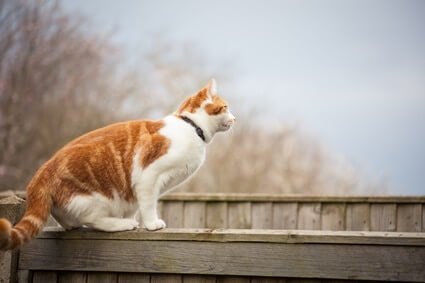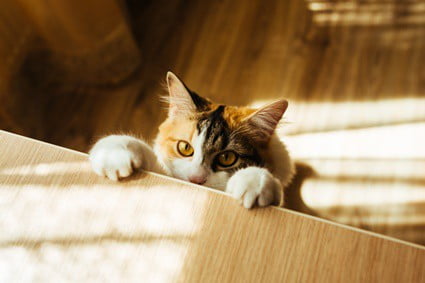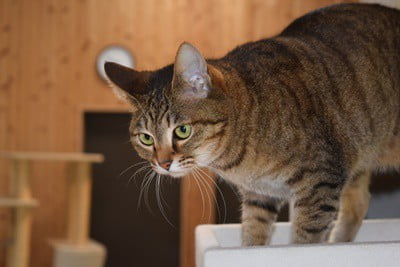Jumping and climbing are instinctive behaviors for cats. Some breeds are more comfortable with heights than others, but perching above ground level enables a cat to survey its territory for dangers. If your cat suddenly appears reluctant to leap to higher elevations, there might be a problem.
Causes of feline lameness include arthritis, leg, paw pad or spinal injuries, sprains, and wounds. Your cat could be struggling with balance or not generating enough power to leap. Also, your cat may instinctively attempt to jump and change its mind due to psychological factors.
Some cats can jump 6 feet high when they’re young and healthy. While senior cats will inevitably move less, a sudden change in demeanor is far more concerning. Check for other variances in feline behavior, as this will enable you to assess if your cat is winding down due to age or its health.
Why Can’t My Cat Jump Anymore?
Any significant change in feline behavior should be investigated as most cats love to leap to and from heights. If your cat is suddenly unable to do so, there will be a reason for this change.
Senior cats are less inclined to make leaps because they don’t want a bad fall. A cat that tries to jump but is unable to do so likely has a health problem.
Cats may suddenly stop jumping for the following reasons:
1/ Arthritis
Veterinary Clinics: Small Animal Practice explains that almost all senior cats have arthritis. It can strike at any age, but most cats that are 10+ have osteoarthritis.
An arthritic cat will struggle with most physical activities, and even walking can result in limping. Don’t wait for your cat to tell you that it’s in pain, as this may never happen.
If your cat isn’t jumping and seems reluctant to move, you need to manage its arthritis pain with non-steroidal anti-inflammatory drugs (NSAIDs), joint supplements, and a comfortable bed.
2/ Excessive Weight
If your cat carries excess weight, it won’t be aerodynamic enough to jump.
The ideal weight for a cat depends on its breed, but you should be able to feel your cat’s ribs. Although some cats have a hanging belly, you shouldn’t see any rolls in the stomach.
Keeping a cat slim is essential as the more weight a cat has to carry, the harder it’ll find movement.
3/ Diabetes
Diabetes is a common side effect of becoming overweight, restricting a cat’s ability to jump.
According to Acta Neuropathologica, your cat may develop diabetic neuropathy, which means your cat will become increasingly unsteady on its feet. Eventually, the hind legs will become completely numb.
This makes jumping impossible as your cat will lack the strength in its hind legs to launch itself.
4/ Broken Bones
Broken or fractured bones are a common explanation for cats failing to jump.
If your cat is particularly stoic, it may not let on that it was injured. If the damaged bone isn’t physically protruding, assessing a break or fracture can be difficult.
Cats can self-heal minor fractures through purring. The vibrations created by this activity promote healing, but the bone can regrow misshapen.
If you suspect that your cat has been involved in an accident, have it checked by a vet.
According to Veterinary Surgery, interlocking nails and wires are recommended for a cat to make a full recovery and jump again. These will hold the bone in place while it repairs.

5/ Sprains and Ligament Tears
Less serious than broken bones, but just as debilitating when it comes to jumping, are sprains. These are muscular injuries that cause weakness in a cat’s legs.
Sprains and tears are usually caused by a cat lunging or jumping too quickly from a standing position. Cats rarely stretch and limber up before exercise, thus increasing the risk of muscular injury.
Little can be done about a feline muscular strain. Your cat will need to rest, but painkillers may be necessary. Most strains will heal themselves in 3-6 weeks.
6/ Hip Dysplasia
As per Veterinary Radiology and Ultrasound, certain breeds of cats are more likely to experience hip dysplasia. Maine Coons, Himalayans, and Persians are at the highest risk.
Hip dysplasia could be a genetic defect or caused by wear and tear. It results in the ball and socket of the hip becoming misaligned, resulting in lameness of the hind legs, making jumping impossible.
Hip dysplasia can be managed with lifestyle changes and pain reduction.
7/ Eyesight Problems
If your cat cannot jump, it could be due to a visual problem.
Many older cats have deteriorating eyesight. Also, the Journal of the American Veterinary Medical Association links sudden-onset blindness with tumors.
Cats rely more on their hearing and sense of smell than their vision, which means that eye issues aren’t always obvious. If a senior cat loses its eyesight gradually, it’ll find ways to overcome this limitation.
Refusal to jump and difficulty negotiating stairs are early warning signs that a cat may be losing its sight.
8/ Ear Infections
Cats rely on their innate sense of balance when jumping, which is how they make seemingly death-defying leaps without hesitation. The Veterinary Journal explains that a cat’s sense of balance is linked directly to its vestibular system.
If your cat has an ear infection, usually caused by ear mites, this will make jumping difficult or impossible, so your cat will struggle with landings and lose all confidence in jumping.
Discoloration inside the ear, along with constant scratching, suggests that a cat has an ear infection.
9/ Paw Health Issues
Before a cat launches itself to jump, it needs to place its paws on the ground. If your cat has issues with its paws or paw pads, this will be an uncomfortable experience.
A common paw complaint is overgrown claws. Cats need to scratch their claws regularly to file them down. If a cat doesn’t scratch, its claws will grow too long. Eventually, they fold over and puncture the paw pads. Get a scratching post to prevent this from happening.
Check that your cat’s paw pads are not dry or cracked, which is common in hot weather. If you notice dry or cracked paws, rub shea butter on the pads for some much-needed moisture.
10/ Cognitive Decline
Once a cat gets older, the risk of feline cognitive dysfunction becomes increasingly pronounced.
According to the Journal of Feline Medicine and Surgery, cognitive decline is separate from simple old age. A cat with this condition is comparable to a human with Alzheimer’s disease.
One of the key symptoms is disorientation, so your cat will wander around, forgetting what it intended to do. This can extend to jumping as the cat will suddenly forget how to leap to a greater height.
11/ Fungal or Bacterial Infection
If your cat wanders outside, it’ll be at risk of fungal or bacterial infections. Other animals, as well as wild soil or water, carry bacteria or fungal spores. Even indoor cats can live in unsanitary conditions.
Some fungal or bacterial infections cause limb weakness and lameness as symptoms, including:
- Coccidioidomycosis (valley fever)
- Blastomycosis
- Bartonella Henselae (cat scratch disease)
Infections can spread, and further complications can arise if these infections go untreated. Also, your cat should be quarantined until it’s fully recovered.
12/ Respiratory Infections (Feline Calicivirus)
According to Research in Veterinary Science, lameness and sudden-onset arthritis are symptoms of feline calicivirus (FCV). A lack of energy could explain your cat’s reluctance to jump.
A respiratory infection is rarely a cause for overt alarm. Most cats recover from these infections by themselves following rest, but senior cats are more at risk from the virus due to their limited immunity.
You can vaccinate your cat against FCV, but no vaccine is 100% effective. Such measures will reduce the impact of this condition as the symptoms of FCV, including lameness, will be less pronounced.
13/ Heart Disease
Senior cats are at greater risk of heart disease (cardiomyopathy). Your cat may have been hiding the signs for some time, but one of the more noticeable symptoms is lameness in the hind legs.
A cat with cardiomyopathy is at risk of an aortic embolism. The Journal of Small Animal Practice explains that an aortic embolism can paralyze a cat’s hind legs. This is because a blood clot will have formed, restricting blood flow to the legs.
Anti-thrombotic drugs can provide temporary relief, restoring the use of a cat’s legs. However, cats will continue to be cautious about jumping.
14/ Slippery Surfaces
If a cat is to jump, it needs a firm footing on the ground. If the ground below a cat’s feet is slippery, jumping may not be possible as it’ll be unable to generate enough momentum to launch.
Cats cannot read “Caution – Wet Floor” signs, so avoid mopping while your cat is active. If you have rugs and mats on the floor, use grips to keep them securely in place.
If it was uncertain on its feet and fell when trying to jump, the cat will remember this bad experience. As a result, the cat may avoid jumping in this spot again.

15/ Objects Have Moved
According to Animal Cognition, cats struggle to remember the location of hidden objects.
Your cat has memorized the layout of your home and knows all the safe jumping points. If you rearrange the furniture in your home, this will no longer be the case, causing distress to your cat.
16/ Lack of Need
Perhaps the cat realized that it didn’t need to jump after starting the process, so it stopped immediately. This is the equivalent of you entering a room then remembering what you need is elsewhere.
17/ Dominant Behavior
Some cats will not jump for the same reason that they won’t use the cat flap. In short, a human will do it for them. This is the belief system of a dominant cat as it wants to let you know who is in charge.
If the cat stares at you and verbalizes, feline dominance is a possible explanation. The cat is letting you know that it wants to reach an elevated height, but you need to pick up the cat and put it there.
These are the most common explanations for a cat no longer jumping. A sudden behavioral change should never be ignored in case your cat needs to be checked over by a veterinarian.


My rescue cat turns 10 yrs this month, & suddenly seems to have difficulty jumping up, looks ready to leap but aborts. Now jumps onto coffee table then onto her stand. Eats, drinks & toilets same. Can’t get her to Vet, she’s terrified of cat box, other people, etc.
I’m having the same issue with my cat who turns 10 years old in 4 months. If you found a solution, please let me know.
I have a senior cat who has always been very agile. She is choosing to sleep in a basket which is new for her. She is also deciding not to jump. She is eating and drinking as usual. She use to come when allied by name but moves away from me rather than coming for a treat. She has never liked to be picked up but will sit on my lap when she wants to. Now she doesn’t jump onto my lap. I’m worried, any suggestions?
I have a Maine coon mix breed that is only 1yr old. She has fur on the bottom of her feet. She did jump before we had her spayed but doesn’t anymore, she will only climb up using her claws.